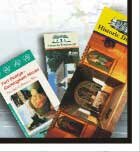
| Home | Search | Sitemap | Help | Contact | Sponsors |
|
|

|

|

|

|
| Home >> Article Database >> Untangling the Web: Getting Alberta Heritage Online |
|
Untangling the Web: Getting Alberta Heritage Online By Adriana A. Davies Many people may still think of "heritage" as merely preserving "old stuff." But we can use the latest technology of the World Wide Web to enlighten them. In 1999, Museums Alberta obtained a grant of $75,750 from the Canadian Millennium Partnership Program for initial website development costs to create Alberta Heritage On-line, containing information about many of our heritage resources. The application included the support of the Cultural Facilities and Historical Resources Division, Alberta Community Development. Project management and implementation has been undertaken by myself for the Heritage Community Foundation which has fast-tracked the project to get the site up before the New Year.
Heritage organizations have within them a great amount of material, potential content for a website. This presents both an opportunity and a challenge. Heritage information is held by various institutions and organizations such as archives, museums, societies dedicated to specific aspects of historical, natural and cultural heritage as well as individuals who are passionate about our heritage. However, at present, no one source or vehicle pulls it together. While a number of heritage institutions and organizations currently have websites, no authoritative "gateway" site to Alberta's heritage exists-another challenge to face, notes Michael Payne, Head of Research and Publications, Community Heritage Services. "The issue for Internet users is not the quantity of information available, but its quality. Teachers at all levels, parents and students themselves are concerned that the information being accessed on the net is accurate, balanced and authoritative. Net users want to be reassured that the sites they consult are enlightening and informative, not dispensing misinformation or, worse still, disinformation. There is a real need for someone to establish the heritage equivalent in Alberta of the 'Good Housekeeping Seal of Website Content Approval'." The public trust mandate of heritage institutions and organizations increases the need to define content standards and a capacity to adhere to them. Nothing like that exists at present, although the Canadian Heritage Information Network (CHIN) has undertaken to develop standards for heritage educational content for the web. We have only begun to address issues of "authority" with respect to content but in the works is the setting up of a Website Editorial Board as well as specialist content committees including representatives from the school system. But, I believe that with Michael Payne, the Provincial Historian, onside and myself as a Senior Editor of the Canadian Encyclopedia responsible for science, technology, industry and material culture we have a pretty good fix on where to find reliable content. We will also be addressing specific audience needs with a priority being curriculum-related content for grades K-12. Content development, site development and maintenance, and hosting are not cheap and the challenge to make use of the new communications technologies comes at a time when government-run heritage facilities have weathered cutbacks. "Marketing on the internet is a real challenge for small attractions, including most museums and historic sites," comments Craig D'Arcy, Marketing Coordinator for Historic Sites Service. "You really need to be on the Web, and people have to be able to find you. One little local website is expensive, and it won't show up on major search engines. By putting a comprehensive database of cultural attractions on Alberta Heritage Online, we can really target consumers of cultural heritage experiences." Content and design have to work together. We know we have to find the most effective way of communicating the heritage of the province-from web design and language, to the content itself. We must marry content to the needs of potential users- school children seeking information for a report, potential visitors to the province, people who are just curious about heritage. We also have to anticipate changes in the technology so we make the right decisions about database design and not exclude potential users and their future needs. We were able to fast-track Alberta Heritage On-Line with support from the CHIN Gateway to Learning Resources project. Through the federal Young Canada Works Program, we recruited two International Interns for a six-month period to assist with content development, as well as one Technical Intern, who is a whiz at database design. With content and funding in place, we still needed a team with the technical know-how to actually get the website up and running. We hired Canadiana Group Inc. (now part of Pangaea Systems Inc.) to develop the site, conduct focus groups, develop a multi-year strategic plan and host the site for one year. The Alberta content of the Alberta-Montana Discovery Guide to museums, parks and historic sites is fully searchable based on attraction name and type, tourism destination region, and location, and is visually rich. However, other parts of the site, Youth & Education, Alberta's History, News & Views and Heritage Resources, at the moment are text heavy as we research and obtain permission for visuals. Getting heritage on the web has required us to think about text, visuals and audio to make it come to life. With the launch of this site, we have an enormous opportunity to communicate what we are all about to new audiences not just in Alberta and Canada, but also around the world. |





 We faced the same challenges as anyone wishing to have an engaging web presence: content, money, and technical know-how.
We faced the same challenges as anyone wishing to have an engaging web presence: content, money, and technical know-how.